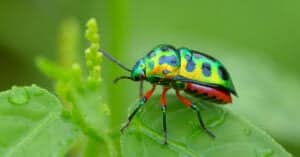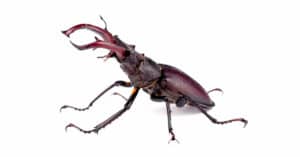Astonishingly, 40% of all known insects are beetles, and beetles native to Virginia make up about the same ratio. There are around 200 types of beetles living in Virginia today, and they come in all sizes, shapes, and colors.
Unfortunately, some are considered pests, but others are genuinely harmless. Virginia is like most states. It has a huge wilderness that dwarfs city, suburban, and small-town areas throughout the state. If you ever need to know how much forest is in your state, take a plane flight.
Beetles are a major part of Virginia’s overall ecosphere, and they have their pros and cons, just like everything else. While it’s very difficult to pinpoint indigenous species of beetles, it’s the opposite when it comes to identifying beetles native to Virginia.
1. Flat-Headed Bald Cypress Sapwood Beetle
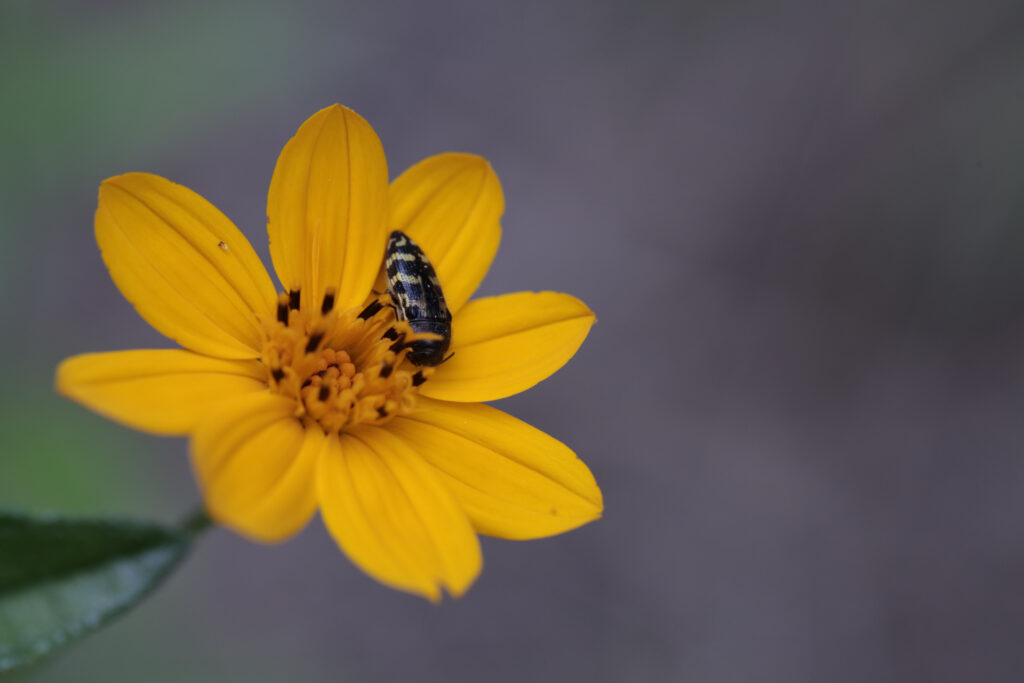
Predators see the yellow and black pattern and mistake the sapwood beetles for
bumblebees
or other stinging insects.
©Cathleen Wake Gorbatenko/Shutterstock.com
One thing is for sure; this beetle has one of the longest names of all the beetles in the state. It’s labeled a ‘rare’ species in the state, and Richmond, Virginia, is where this beetle is spotted the most. It’s a pretty little beetle, about 1/3 to 1/2″ in length, and its body is a scattering of black and yellow spots.
The Flat-Headed Bald Cypress Sapwood Beetle is a ‘hard’ beetle, meaning it feels like a small rock if you pick one up. They tend to burrow into trees of all kinds and even the occasional light pole or two. The intricate patterns of yellow and black warn potential predators to stay away.
Predators see the yellow and black pattern and mistake the sapwood beetles for bumblebees or other stinging insects. While they are considered rare species, nothing is in place to protect them, and they aren’t listed on any endangered species lists.
2. Fire-Colored Beetle
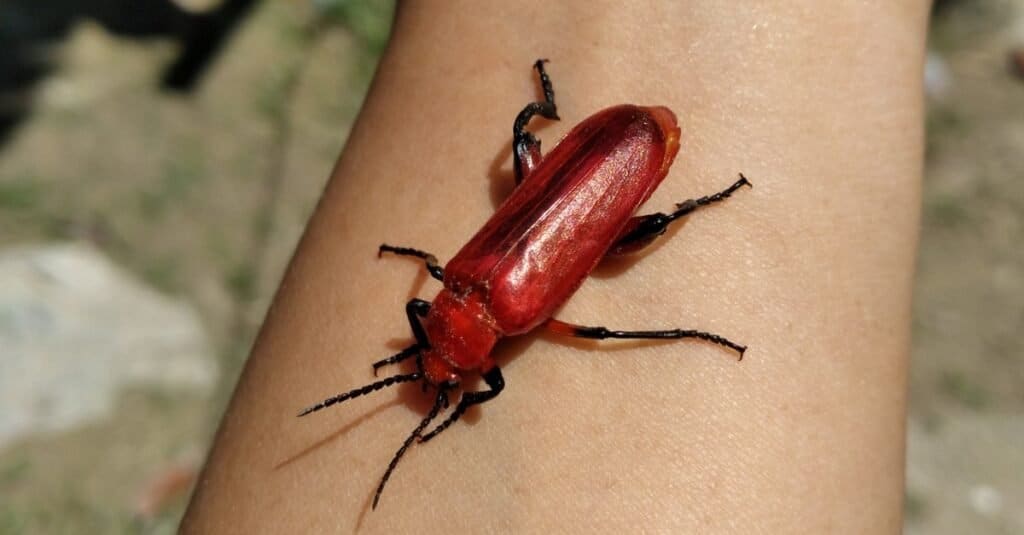
A fire-colored beetle on a person’s arm. This colorful beetle is not poisonous.
©Heywidh/Shutterstock.com
The fire-colored beetle is wicked-looking when it’s still in the larvae stage. However, it resembles a simple love bug when it becomes an adult. It has a long, black body with a small redhead. There is also the opposite version: a fiery red body and a dark, black head.
Either way, it’s nowhere near as intimidating as the larvae. The larvae are often twice as long as an adult, measuring 1.35″. Adults are far more petite, often measuring no more than 3/4 of an inch. Plus, adults look pretty standard, while the larvae have a pair of wicked-looking, harmless pincers.
Fire-colored beetles have long wings, but they can’t fly anywhere. Instead, they flap their wings and glide from one location to another, much like a palmetto bug will semi-fly. It’s also the reason so many end up splatted on windshields.
3. Emerald Ash-Borer
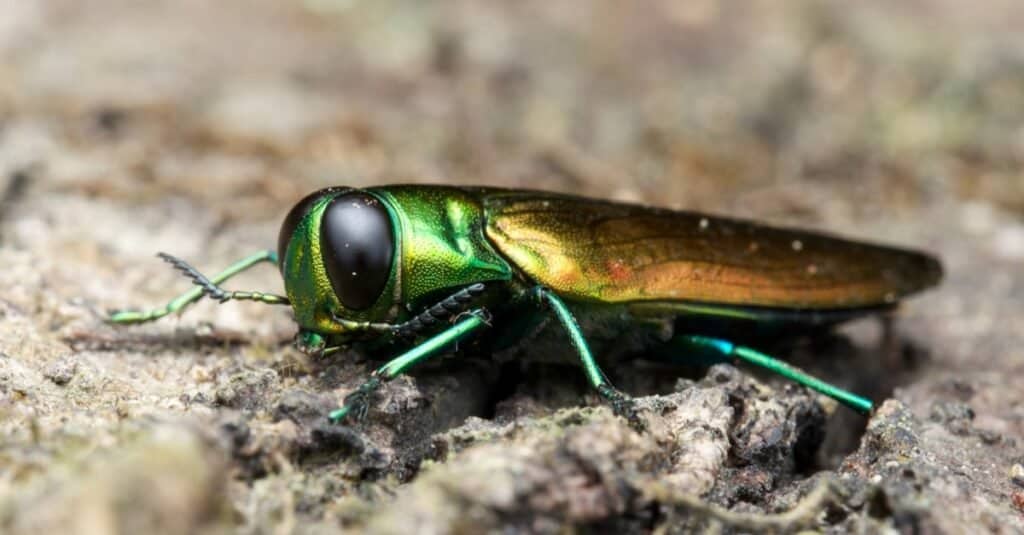
The Emerald Ash Borer, a type of beetle, kills ash trees by destroying the water and nutrient-conducting tissues under the tree’s bark.
©Herman Wong HM/Shutterstock.com
Another one of the many metallic-colored beetles, the Emerald Ash-Borer, as its namesake suggests, is emerald-metallic in appearance. The adult males will generally reach 1/2″ in length at full growth, and, no, they don’t like ashes. Rather, they prefer the hospitality of an ash tree.
So much so that Emerald Ash-Borers are responsible for the wholesale devastation of ash forests. Like many beetle species, they prefer to bore into ash trees, where they build their nest and where most of their life cycle occurs.
They’re so bad that they threaten millions of ash trees worldwide, including in Virginia. They are typically eradicated when discovered by park management because failing to do so will have disastrous and long-term consequences.
4. Click Beetle
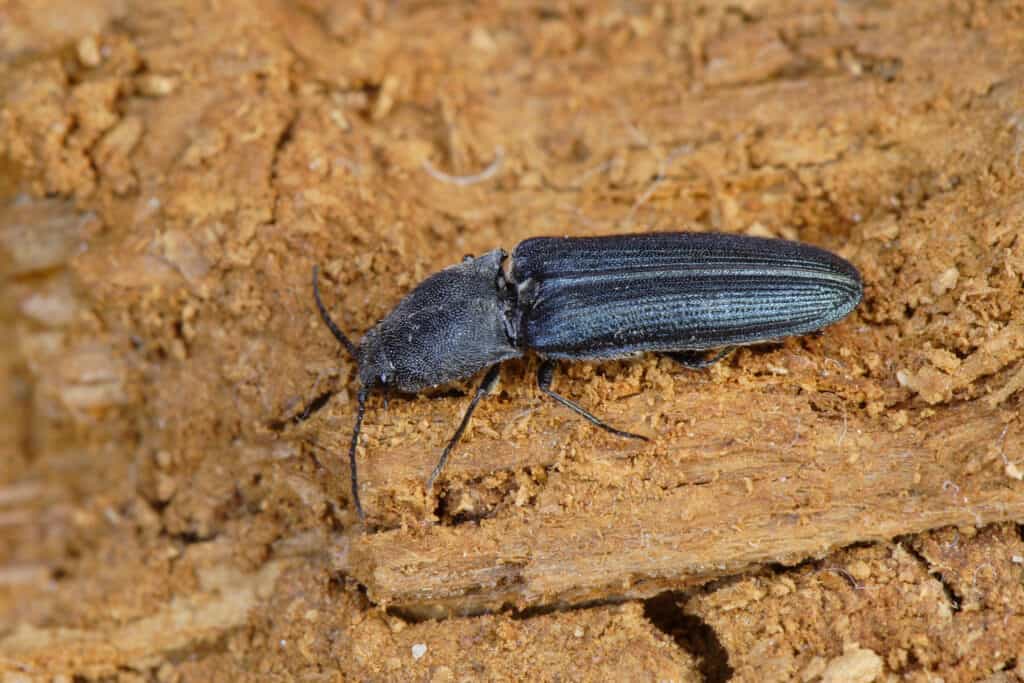
Click beetles glow continuously, although they can control the light intensity.
©Petr Muckstein/Shutterstock.com
The click beetle is an interesting beetle with antennae that look like massive eyelash extensions. They get their name from the clicking sound emanating from their legs when they slap them together. They are very small in length, only about 1/10 to 1/8 of an inch, and are typically a dusky brown color that contrasts against their black eyelash antennae.
Since they are nocturnal beetles, it’s rare to spot one out and about in the middle of the day. However, turn your porch light on, and you’re bound to introduce yourself to one sooner rather than later. Their dusky brown appearance is excellent camouflage, making them even harder to see, day or night.
These clicking gliders are herbivores, so you don’t have to worry about stings or bites, and they won’t clear out the mosquitoes at nighttime either.
5. Earth-Boring Scarab Beetle
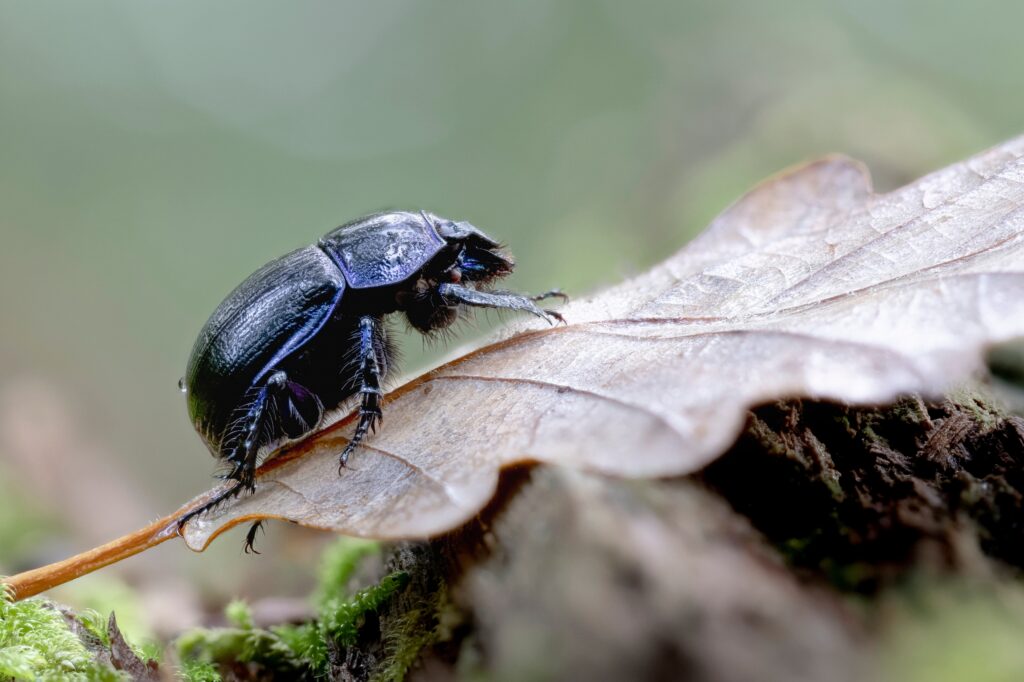
The earth borer is critical to its surrounding environment, as it feeds on fecal matter, decaying flesh, fungi, and other harmful substances left behind by others.
©DKeith/Shutterstock.com
An earth-boring scarab beetle looks like a cross between a spider and a Kevlar helmet. Thick, hairy legs protruding from a candied orange and brown, segmented, rounded shell. They also feature several black patterns on their bodies, and they’re shaped like bulldogs.
They aren’t the largest of beetles but aren’t the smallest, typically measuring about 1/4 of an inch. Unlike the emerald ash borer, the earth borer is critical to the surrounding environment, as it feeds on fecal matter, decaying flesh, fungi, and other harmful substances left behind by others.
They’re effectively the ‘jack of all trades, master of no clean-up crew. They don’t focus on any one thing in particular, like dung beetles. Rather, they focus on many things. They will burrow underneath tree bark to give birth but nowhere near the same level of an ash borer, the latter of which is far more devastating.
6. Flower Longhorn Beetle
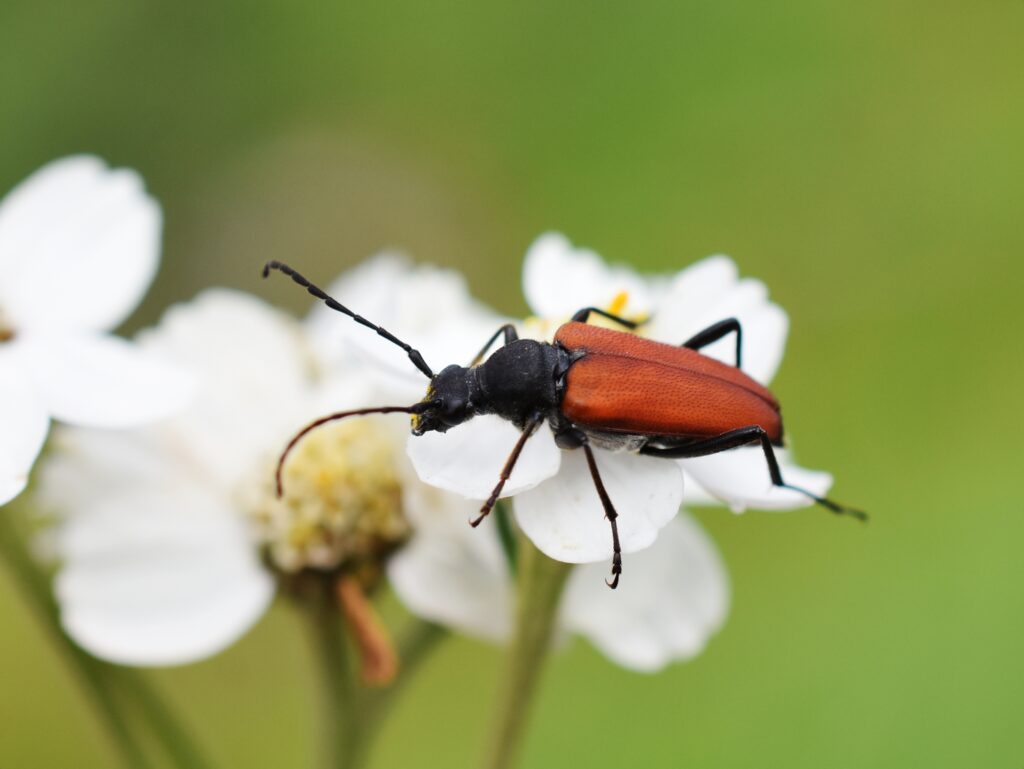
The flower longhorn beetle is a similar brown to the German
cockroach
, with black or yellow wingtips and a splash of black and yellow just below their heads.
©HHelene/Shutterstock.com
The flower longhorn beetle is one of the longer beetles native to Virginia, similar in shape to the fire-colored beetle but even longer. As their name implies, flower longhorn beetles spend much of their free time feasting on pollen, so there’s always a good chance you’ll find them in a field of wildflowers.
They are a similar brown to the German cockroach, with black or yellow wingtips and a splash of black and yellow just below their heads. As pollinators go, flower longhorn beetles are nearly as effective as bees, though they can’t fly with the same level of precision.
They do tend to get indoors and scare the living daylights out of people as they fly in a straight line from point A to point B. However, they are mostly harmless.
7. Ant-Like Longhorn Beetle
The ant-like longhorn beetle gets its name from its ant-like appearance. Imagine that. They belong to a massive family of wood-boring beetles, and that’s exactly what they do—bore into wood. They aren’t as destructive as the emerald ash borers, but it will get problematic if you get enough of them together.
Roughly 1/2 an inch in length at full adulthood, ant-like longhorn beetles happily avoid people’s homes. So don’t expect to find them there. If they get inside your home, it’s a rarity and most likely happened by accident.
They lack the destructiveness of other borer beetle types because of their diversity in tree choices. Ant-likes prefer ash, maple, hemlock, fir, oak, and pine. That diversification in tree choice keeps them from being particularly destructive to a single tree type.
8. Big Dipper Fire Fly
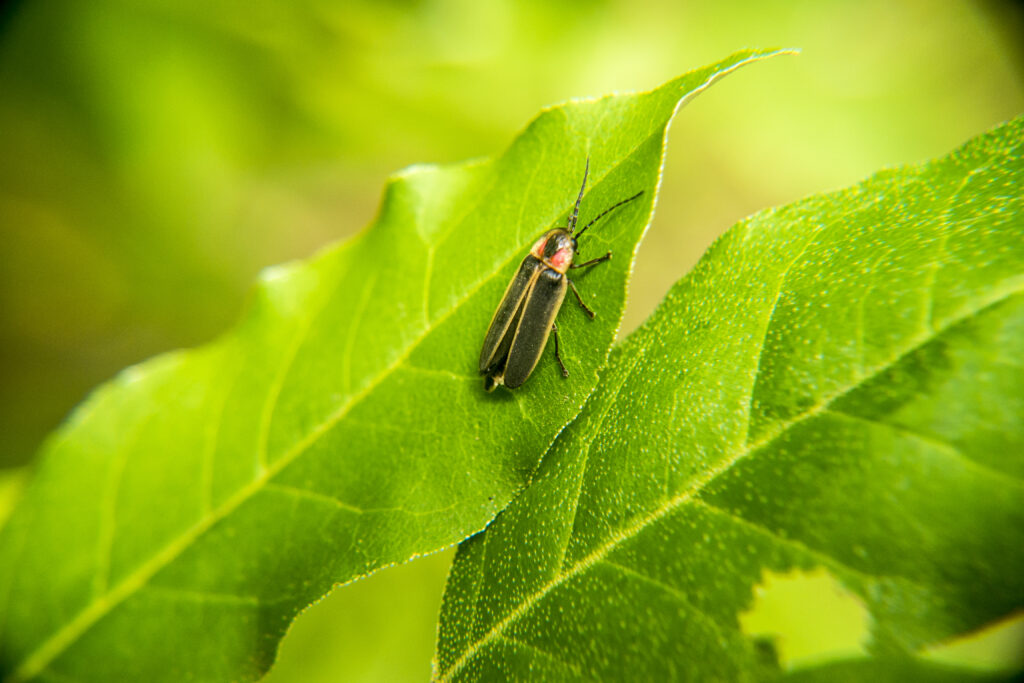
The big dipper firefly loves to put on a show during mating season (May through September), lighting up the night sky with an iridescent glow from its abdomen.
©Neal Parr/Shutterstock.com
This beetle type eschews trees altogether, whether it’s in the adult or larvae stage. Big dipper fireflies are typically found when you kick over a stone or a large chunk of a felled tree out in the middle of nowhere. Their life cycle begins and ends there.
However, they aren’t known for where they sleep nearly as much as for what they do. The big dipper firefly loves to put on a show during mating season (May through September), lighting up the night sky with an iridescent glow from its abdomen.
The way the males fly and light up suggests they light their bioluminescence by bouncing up and down in the air, mixing the liquid within their abdomens, and creating a chemical reaction. However they do it, it’s impressive when a couple of thousand gather in an open meadow at dusk.
9. Black Carpet Beetle
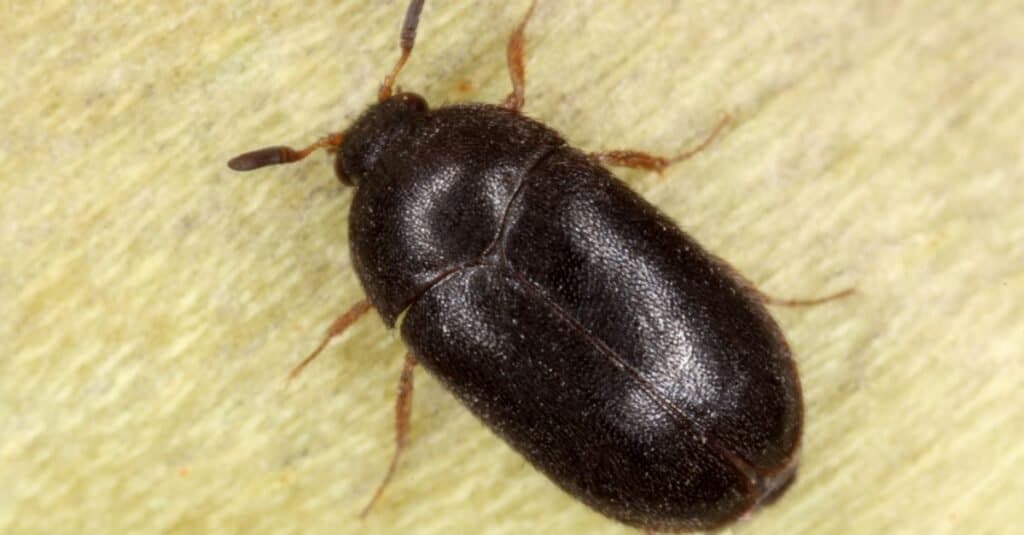
One of the most common big black beetles found in the yard is the black carpet beetle.
©Tomasz Klejdysz/Shutterstock.com
Throwing a carpet beetle into the list is always a good idea. It helps remind people there are beetles out there that would love nothing more than to feast on their carpets. There are a ton of carpet beetles out there (over 400 species, in fact), and the black carpet beetle is certainly one of them.
Like all carpet beetles, the black carpet beetle mainly feeds on keratin found in human and pet hair. Since human and pet hair eventually ends up on the carpet, there’s no better place for a black carpet beetle to be.
They’ll happily chew out the corners of your carpet and holes through it if you fail to recognize them early on.
10. Black Vine Weevil
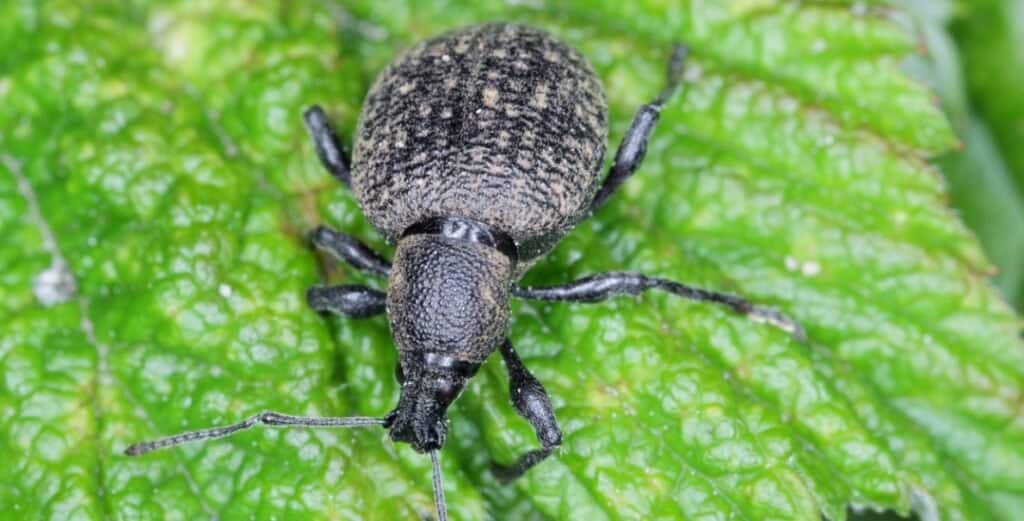
The black vine weevil beetle.
©iStock.com/Tomasz Klejdysz
The black vine weevil sounds like a pretty insidious little beetle. Unfortunately, they are capable of ravaging crops even if they’re having a particularly bad day. They mostly prefer plants in their very early stages but will also go after most vegetable crops.
Worse yet, they lay their eggs on these crops, and when the grubs emerge, they join in on the feast, only consuming more as they transform. The grubs feed on the roots, while the adults feed on the leaves and stalks.
An adult black vine weevil is about 1/2″ long and is all black except its yellow legs, which are sometimes dark enough to constitute the ‘brown’ adjective.
Final Thoughts
Love them or hate them, beetles are a distinct and necessary part of life in Virginia. There are many beetles native to Virginia as well, more than this list could cover in a single article. However, the above ten are some of the most common beetles native to Virginia, along with a scattering of unique ones.
Most Virginians won’t argue with the big dipper firefly, thanks to its beautiful, nightly displays in the middle of the summer. Unfortunately, some beetles are nothing more than a blight on trees and farmland, creating havoc for Virginians, whether inside or outside the home.
Either way, it’s all a part of the cycle, and Virginia is a huge and beautiful home for many beetle species.
The photo featured at the top of this post is © HHelene/Shutterstock.com
Thank you for reading! Have some feedback for us? Contact the AZ Animals editorial team.



